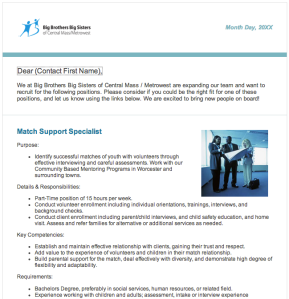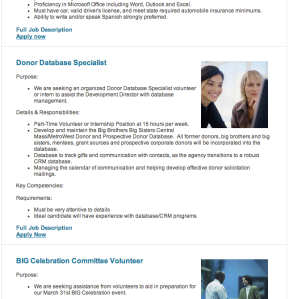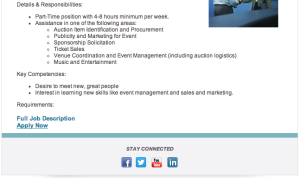Today I read the article “Organisational brand identity management: a critical asset for sustainable competitive advantage by non-profit” by C. Olusanmi Amujo and B. Adeyinka Laninhun for the January 2013 edition of the Third Sector Review journal. As indicated in the title, I thought this would be a fitting read for my work with BBBSCM given their status as a non-profit. Also, considering my position as Marketing Intern, I feel knowledge about BBBSCM’s brand identity, management, and communication of such is always beneficial to my work.
One interesting thing about this article is that with every discussion of non-profit brand x, y, and z, it presents the alternative definition or perspective that pertains to FOR-profit corporations. The article states that branding has ability to facilitate donor understanding and support of non-profits and that brands remain a largely underutilized strategic asset within the non-profit sector. I think BBBSCM has an advantage in this area because of its status as a chapter, or local section of a national and international organization. This means, BBBSCM already has a lot of set branding tools–a recognizable/familiar logo, one consistent mission and vision, to name a few. One thing BBBSCM does well is make sure that its logo is tied to nearly everything it puts out to the public/donors. As I noted in a recent blog post about the National Women’s History Month, I made a very unfortunate mistake of forgetting to include the BBBSCM logo as a watermark or free standing logo in the video, which is not only important for brand recognition and identity management but also for consistency reasons (the last video I did include the watermarked logo throughout). So this would be one thing to improve upon.
“In order to prevent multiple brand personalities being held by a non-profit’s internal stakeholders, or brand identity dissonance among its external stakeholders, effective, consistent and unified organisational brand personality redeployment is crucial. The non-profit’s brand identity strategists should consistently reaffirm its organisational attributes to the stakeholder groups. Consistent and clear articulation of these attributes –which include the organisation’s mission statement–through various communication media is essential in order to reaffirm the organisational personality to the non-profit’s stakeholders.”
This paragraph brings to mind one way BBBSCM could improve upon its brand identity and management. I’ve noticed that many staff members (and there is a small total staff of 15) either don’t have an email signature at all or have one that varies greatly from others’. While this is just one small form of communication media, it is a very simple and clear way of consistently making the same point about the brand-you’re-aligned-with’s identity. I’ve noticed that in my own life, I constantly check people’s email signatures for credibility about who they are, where they come from, what they do, and how to reach them. With this in mind, one small step BBBSCM could make towards more consistent brand identity would be to have a universal format for email signatures that include the logo, contact information, name, position, website URL, and maybe even a slogan ( “Helping Kids Soar” is one of ours). I think this is definitely the intention of BBBSCM, but somehow has not been fully implemented.
“Consistent redeployment of brand personality attributes–such as caring, trustworthy, passionate, accountable, transparent, empathy and innovative–by a non-profit to its stakeholders is essential for organisational personality differentiation.”
Continuing on this note, one of the ways I was hoping to improve upon “brand personality redeployment of attributes” was by creating our Social Media Strategy. While I often find myself without enough time to consistently check and update our social media platforms according to this plan, the goal I had with this strategy was to create a system in which followers are familiar with/know what to expect for the types of things we post. By posting certain types of content on a consistent schedule, BBBSCM would be able to communicate a–again–consistent and clear message about who we are and what personality attributes we hold.
“Two critical challenges of non-profit effectiveness are management effectiveness and programme effectiveness (Sowa et al. 2004). Non-profits with high performance measures that deliver a high social impact on society may be attractive to key stakeholders. Donors may thus show greater interest and commit to funding their services.”
Lastly, one thing BBBSCM does relatively well is communicating its “impact statistics” clearly and often (when applicable). One example of this is in the 2013 Annual Report, which of course will go directly to stakeholders and donors. As you can see, throughout the PDF there are many highlighted statistics, reiterating the tangible effect BBBSCM makes and can make in just one year. While I would be surprised if an organization DIDN’T do this well, it’s nice to see that BBBSCM is properly leveraging its impact on society in order to be attractive to stakeholders and entice donors for funding.


